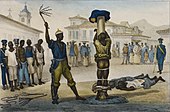Switch (corporal punishment)
This articleneeds additional citations forverification.(December 2014) |
| Part ofa serieson |
| Corporal punishment |
|---|
 |
| By place |
| By implementation |
| By country |
| Court cases |
| Politics |
| Campaigns against corporal punishment |
Aswitchis a flexible rod which is typically used forcorporal punishment.Switching is similar tobirching.
Punitive switching
[edit]Switches are typically made of strong and flexible wood such ashazel,birch,orhickory.[citation needed]Willowbranches are also used, as well as branches from strong trees and large shrubs. Switches are often from a garden or an orchard nearby, or taken from the wild. In the SoutheasternUnited States,fresh-cut, flexible cane (Arundinaria) is commonly used.[citation needed]In the 20th and 21st centuries the use of corporal punishment has been criticized, in bothNorth AmericaandEurope.[1]

Making a switch involves cutting it from the stem and removing twigs or directly attached leaves.[citation needed]For optimal flexibility, it is cut fresh shortly before use, rather than keeping it for re-use over time.[citation needed]Some parents decide to make the cutting of a switch an additional form of punishment for a child, by requiring the disobedient child to cut their own switch.[citation needed]
- Thetamarind switch(in Creole Englishtambran switch) is a judicial birch-like instrument for corporal punishment made from threetamarindrods, braided and oiled, used long after independence in the Caribbean Commonwealth island states ofJamaicaandTrinidad and Tobago.[2]
- TheGilbertesetribal community atWaginain Choiseul province (Solomon Islands) reintroduced by referendum in 2005 traditional "whipping" withcoconut treebranches for various offences – the national justice system opposes this.[3]
See also
[edit]- Caning
- Corporal punishment in the home
- Judicial corporal punishment
- School corporal punishment
- Switchgrass
- Switchcane
References
[edit]- ^Gould, Mark (January 9, 2007)."Sparing the Rod".The Guardian.London.RetrievedFebruary 5,2009.
- ^Parker, Quincy (March 7, 2007)."Human Rights Abuse Concerns".The Bahama Journal.Nassau.RetrievedFebruary 5,2009.
- ^"Floggings cut crime: village leader".The Sydney Morning Herald.AAP. March 9, 2006.RetrievedFebruary 5,2009.
